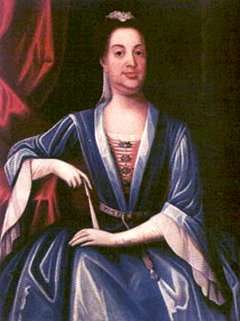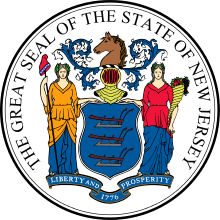Edward Hyde, 3rd Earl of Clarendon
| Edward Hyde, 3rd Earl of Clarendon | |
|---|---|
| 1st Governor of New Jersey in British North America | |
|
In office 1701–1708 | |
| Monarch | Anne |
| Lieutenant |
Col. Richard Ingoldesby Lieutenant-Governor |
| Preceded by | Office created |
| Succeeded by | John, 4th Baron Lovelace |
| 14th colonial Governor of New York | |
|
In office 1702–1708 | |
| Monarch | Anne |
| Preceded by | John Nanfan |
| Succeeded by | John, 4th Baron Lovelace |
| Personal details | |
| Born |
The Hon. Edward Hyde 28 November 1661 England |
| Died |
31 March 1723 (aged 61) Chelsea, London, England |
| Resting place | Westminster Abbey |
| Political party | Tory |
| Spouse(s) | Katherine O'Brien, 8th Baroness Clifton |
| Children | Edward, 9th Baron Clifton; Catherine; Mary; Flora; Theodosia; 10th Baroness Clifton |
| Profession | Diplomat and Governor in British North America |
| Religion | Anglican |
Edward Hyde, 3rd Earl of Clarendon (28 November 1661 – 31 March 1723), styled Viscount Cornbury between 1674 and 1709, was Governor of New York and New Jersey between 1701 and 1708, and is reputed to have had a predeliction for cross-dressing while in Crown office.
Career
Born The Honourable Edward Hyde, the only child of Henry, Viscount Cornbury (1638–1709), eldest son of the 1st Earl of Clarendon and the former Theodosia Capell (1640–1662), daughter of Arthur Capell, 1st Baron Capell of Hadham, and sister of the 1st Earl of Essex, he was the nephew of Lady Anne Hyde, Duchess of York, wife of the future King James II, and the cousin of Queen Anne. From the age of nine, after his father's second marriage to the heiress Flower Backhouse, Edward Hyde lived at Swallowfield Park in Berkshire.
He studied at Oxford, matriculating on 23 January 1675, a month after his father succeeded as 2nd Earl of Clarendon, whereby he became styled Viscount Cornbury. He joined the Royal Regiment of Dragoons before being elected as a Tory Member of Parliament for Wiltshire from 1685–1696 and for Christchurch 1695–1701. He was Master of the Horse to Prince George of Denmark, and a Page of Honour to King James II at his Coronation. He was one of the first commanders to desert the King in 1688, taking with him as many troops as he could.
Also in 1688, Lord Cornbury married, in a clandestine ceremony, Lady Katherine O'Brien, only surviving child and heiress of Henry, Lord Ibrackan, eldest son of the 7th Earl of Thomond; Viscountess Cornbury succeeded her mother in 1702 as 8th Baroness Clifton, in her own right. Lady Cornbury died in New York on 11 August 1706 and is buried at Trinity Church, New York.
As Lord Cornbury, he became Governor of New York and New Jersey from 1701 to 1708. In 1707 the governor ordered prosecution of Rev. Francis Makemie, leader of the first Presbyterian synod in the new country, for preaching without a license (Makemie was acquitted but moved down the Delmarva Peninsula out of Lord Cornbury's jurisdiction). It is said that the governor's character and conduct were equally abhorred in both hemispheres. Lord Clarendon was imprisoned for debt at the time of his father's death, when he succeeded as 3rd Earl of Clarendon. He was Envoy Extraordinary to Hanover in 1714.
Lord Clarendon died at Chelsea in obscurity and in debt and was buried on 5 April 1723 in Westminster Abbey. Although his eldest son, Edward, Viscount Cornbury, predeceased him without children (the Earldom passing on his death to his cousin, the 2nd Earl of Rochester), by his daughter Lady Theodosia Hyde, who married John Bligh (created Earl of Darnley in 1725), he has many descendants alive today, including among others actor Cary Elwes (qv. Elwes family of Billing Hall), TRH Princesses Beatrice and Eugenie of York, through their mother Sarah, Duchess of York, as well as the present Earls of Clarendon, of the present (1776) creation.
Reputation

Viscount Cornbury came to be fabled in historical literature as a moral profligate, sunk in corruption: possibly the worst governor Britain ever appointed to an American colony.[1] The early accounts claim he took bribes and plundered the public treasury. Nineteenth century historian George Bancroft said that Cornbury illustrated the worst form of the English aristocracy's "arrogance, joined to intellectual imbecility". Later historians characterise him as a "degenerate and pervert who is said to have spent half of his time dressed in women's clothes", a "fop and a wastrel". He is said to have delivered a "flowery panegyric on his wife's ears" after which he invited every gentleman present to feel precisely how shell-like they were; to have misappropriated £1,500 meant for the defence of New York Harbor, and, scandalously, to have dressed in women's clothing and lurked "behind trees to pounce, shrieking with laughter, on his victims".[2]
Cornbury is reported to have opened the 1702 New York Assembly clad in a hooped gown and an elaborate headdress and carrying a fan, imitative of the style of Queen Anne. When his choice of clothing was questioned, he replied, "You are all very stupid people not to see the propriety of it all. In this place and occasion, I represent a woman (The Queen), and in all respects I ought to represent her as faithfully as I can." It is also said that in August 1707, when his wife Lady Cornbury died, His High Mightiness (as he preferred to be called) attended the funeral dressed as a woman. It was shortly after this that mounting complaints from colonists prompted The Queen to remove Cornbury from office.[3]
In 2000 Patricia U. Bonomi re-examined these assertions and found them to be questionable and based on very little evidence. Three colonials, all members of a faction opposed to Cornbury, wrote four letters between 1707 and 1709 discussing a rumour that Lord Cornbury wore women's clothes. There are also some early documents that might be cited to support charges of having taken bribes or misappropriated government funds, but there the contemporary evidence ends.[4]
A portrait possibly of Lord Cornbury dressed in women's clothes which hangs at the New York Historical Society. Philip Davenport-Hines, a Fellow of the Royal Historical Society, thinks the portrait accurately depicts Cornbury and pronounced Bonomi's findings inconclusive.[5]
New York Governor
In the interim after Cornbury's time as Governor of New York, there were several acting governors:
- Lord Lovelace (1708–1709 as Governor)
- Pieter Schuyler (1709 as Acting Governor) (also 1719–1720)
- Richard Ingoldesby (1709–1710 as Acting Governor)
- Gerardus Beekman (1710 as Acting Governor)
In 1710, General Robert Hunter FRS arrived to fill the post.
Styles of address
- 1661-1674: The Honourable Edward Hyde
- 1674-1685: Viscount Cornbury
- 1685-1701: Viscount Cornbury MP
- 1701-1709: Viscount Cornbury
- 1709-1723: The Right Honourable The Third Earl of Clarendon
In fiction
Cornbury is the lead character in the play Cornbury: The Queen's Governor - first presented as a staged reading at The Public Theater on 12 April 1976, the play was written by William M. Hoffman and Anthony Holland. Joseph Papp produced and Holland directed, with Joseph Maher in the role of Cornbury.[6] The play was revived in 2009 at the Hudson Guild Theater under the direction of Tim Cusack. David Greenspan played Cornbury.[7]
He also makes appearances in Edward Rutherfurd's historical saga novel New York and in Robert McCammon's "Matthew Corbett" series of novels.
See also
References
- ↑ The First Transgender Governor of New York
- ↑ Ross, Shelley, Fall From Grace, Random House, 1988. P.4. ISBN 0-517-19830-4.
- ↑ Fall From Grace, P.4-7
- ↑ Bonomi, Patricia U. Lord Cornbury Scandal: The Politics of Reputation in British America, The University of North Carolina Press, 2000. ISBN 0-8078-4869-7.
- ↑ Armstrong, Kiley, Historical Society Ponders Man in Dress. Associated Press, 31 May. 1990.
- ↑ Hoffman, William M. (ed) (1979). Gay Plays: The First Collection. New York, New York: Avon Books. pp. 413–14. ISBN 0380427885.
- ↑ Isherwood, Charles (2009-01-30). "The Man Who Would Be Queen". The New York Times. Retrieved 2012-10-11.
External links
- Did New York once have a transvestite governor?
- Royal Berkshire History: Edward Hyde, 3rd Earl of Clarendon
